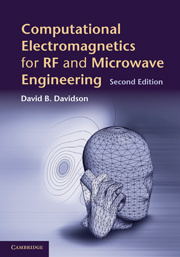Description
Computational Electromagnetics for RF and Microwave Engineering (2nd Ed.)
Author: Davidson David B.
A hands-on introduction to computational electromagnetics, linking theoretical coverage to open-source MATLAB codes and including many practical hints and tips.
Language: English
Subject for Computational Electromagnetics for RF and Microwave...:
Approximative price 68.67 €
In Print (Delivery period: 14 days).
Add to cart
Publication date: 10-2010
530 p. · 18x25.3 cm · Hardback
530 p. · 18x25.3 cm · Hardback
Description
/li>Contents
/li>Biography
/li>
This hands-on introduction to computational electromagnetics (CEM) links theoretical coverage of the three key methods - the FDTD, MoM and FEM - to open source MATLAB codes (freely available online) in 1D, 2D and 3D, together with many practical hints and tips gleaned from the author's 25 years of experience in the field. Updated and extensively revised, this second edition includes a new chapter on 1D FEM analysis, and extended 3D treatments of the FDTD, MoM and FEM, with entirely new 3D MATLAB codes. Coverage of higher-order finite elements in 1D, 2D and 3D is also provided, with supporting code, in addition to a detailed 1D example of the FDTD from a FEM perspective. With running examples through the book and end-of-chapter problems to aid understanding, this is ideal for professional engineers and senior undergraduate/graduate students who need to master CEM and avoid common pitfalls in writing code and using existing software.
1. An overview of computational electromagnetics for RF and microwave applications; 2. The finite difference time domain method: a one-dimensional introduction; 3. The finite difference time domain method in two and three dimensions; 4. A one-dimensional introduction to the method of moments: thin-wire modelling; 5. The application of the FEKO and NEC-2 codes to thin-wire antenna modelling; 6. The method of moments for surface modelling; 7. The method of moments and stratified media: theory; 8. The method of moments and stratified media: practical applications of a commercial code; 9. A one-dimensional introduction to the finite element method; 10. The finite element method in two dimensions - scalar and vector elements; 11. The finite element method in three dimensions; 12. A selection of more advanced topics in full-wave computational electromagnetics; Appendices.
David Davidson is a Professor in the Department of Electrical and Electronic Engineering at Stellenbosch University, South Africa, from where he received his PhD in 1991. He is a Senior Member of the IEEE, edits the EM Programmers Notebook in the IEEE Antennas and Propagation Magazine and is the recipient of numerous awards, including the South African National Research Foundation President's Award and the Rector's Award for Excellent Research from Stellenbosch University. His main research interest is CEM; he has published extensively on this topic and has contributed to commercial software.
© 2024 LAVOISIER S.A.S.




